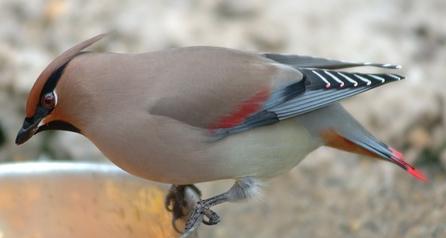|
| 질의: description | 결과: 9463번째/10150 | |
Japanese Waxwing (Bombycilla japonica) - Wiki
| 제목: | Japanese Waxwing (Bombycilla japonica) - Wiki
| |

| 해상도: 446x238
파일크기: 12542 Bytes
등록시간: 2008:01:11 11:49:17
|
Japanese Waxwing
From Wikipedia, the free encyclopedia
Order: Passeriformes
Family: Bombycillidae
[Photo] Japanese Waxwing (Bombycilla japonica). Photo by Jason L. Buberel (www.buberel.org/gallery/).
The Japanese Waxwing (Bombycilla japonica) is a fairly small passerine bird of the waxwing family found in north-east Asia. It feeds mainly on fruit and berries but also eats some insects during the summer. The nest is a cup of twigs lined with grass and moss which is built in a tree.
Description
The bird is about 18 cm in length and its plumage is mostly pinkish-brown. It has a pointed crest, a black throat, a black stripe through the eye, a pale yellow centre to the belly and a black tail with a red tip. The wings have a pattern of black, grey and white with a reddish-brown stripe running across them. The call is a high-pitched trill but there is no true song.
Unlike the other species of waxwing, it lacks the row of waxy red feather-tips on the wing which gives the birds their name. Japanese Waxwings often occur in mixed flocks with Bohemian Waxwings which, as well as having the row of waxy tips, are slightly larger with a yellow tail-tip, greyish centre to the belly and no reddish-brown stripe across the wing.
Distribution and habitat
The Japanese Waxwing breeds in coniferous forests in the Russian Far East and in Heilongjiang province, north-east China. It is at some risk of becoming threatened with extinction due to loss and degradation of its forest habitat.
It winters in Japan, Korea and eastern China; the exact distribution is irregular as flocks move in search of berries and birds may be common in an area one year and scarce the next. In Japan it is present from November to April; few birds winter on Hokkaid?? but in south-western Japan, it outnumbers the Bohemian Waxwing. The winter habitat is open woodland or farmland in the lowlands or low mountains and birds frequently visit berry-laden trees in parks and gardens.
Vagrant birds appear in Hong Kong, central China and Taiwan but records from Europe are more likely to be escapes from captivity than genuinely wild birds.
http://en.wikipedia.org/wiki/Japanese_Waxwing
| The text in this page is based on the copyrighted Wikipedia article shown in above URL. It is used under the GNU Free Documentation License. You may redistribute it, verbatim or modified, providing that you comply with the terms of the GFDL. |
|
^o^
동물그림창고 똑똑전화 누리집
^o^
|
|